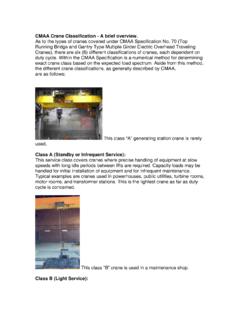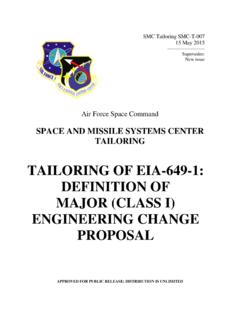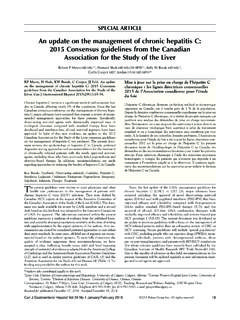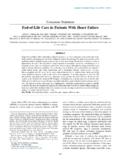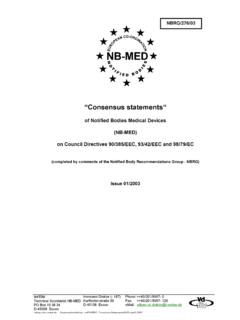Transcription of CMAA Crane Classification - A brief overview. Class A ...
1 CMAA Crane Classification - A brief overview . As to the types of cranes covered under CMAA Specification No. 70 (Top Running Bridge and Gantry Type Multiple Girder Electric Overhead Traveling Cranes), there are six (6) different classifications of cranes, each dependent on duty cycle. Within the CMAA Specification is a numerical method for determining exact Crane Class based on the expected load spectrum. Aside from this method, the different Crane classifications, as generally described by CMAA, are as follows: Class A (Standby or Infrequent Service): This service Class covers cranes where precise handling of equipment at slow speeds with long idle periods between lifts are required. Capacity loads may be handled for initial installation of equipment and for infrequent maintenance. Typical examples are cranes used in powerhouses, public utilities, turbine rooms, motor rooms, and transformer stations. This is the lightest Crane as far as duty cycle is concerned.
2 Class B (Light Service): This service Class covers cranes where service requirements are light and the speed is slow. Loads may vary from no load to occasional full rated loads with 2 to 5 lifts per hour, averaging 10 feet per lift. Typical examples are cranes in repair shops, light assembly operations, service buildings, light warehousing, etc. Class C (Moderate Service): This service covers cranes whose service requirements are deemed moderate, handling loads which average 50 percent of the rated capacity with 5 to 10 lifts per hour, averaging 15 feet, with not over 50 percent of the lifts at rated capacity. Typical examples are cranes used in machine shops, papermill machine rooms, etc. Class D (Heavy Service): In this type of service, loads approaching 50 percent of the rated capacity will be handled constantly during the work period. High speeds are desirable for this type of service with 10 to 20 lifts per hour averaging 15 feet, with not over 65 percent of the lifts at rated examples are cranes used in heavy machine shops, foundries, fabricating plants, steel warehouses, container yards, lumber mills, etc.
3 , and standard duty bucket and magnet operations where heavy duty production is required. Class E (Severe Service): This type of service requires a Crane capable of handling loads approaching the rated capacity throughout its life with 20 or more lifts per hour at or near the rated capacity. Typical examples are magnet, bucket, magnet/bucket combination cranes for scrap yards, cement mills, lumber mills, fertilizer plants, container handling, etc. Class F (Continuous Severe Service): In this type of service, the Crane must be capable of handling loads approaching rated capacity continuously under severe service conditions throughout its life. Typical examples are custom designed specialty cranes essential to performing the critical work tasks affecting the total production facility, providing the highest reliability with special attention to ease of maintenance features. AISE Service Class - A brief overview . Not to be outdone by CMAA, AISE also provides for different service classes for cranes covered under AISE Technical Report No.
4 6, "Specifications for Electric Overhead Traveling Cranes for Steel Mill Service". Like CMAA, AISE also provides a numerical method for determining Crane Class based on the expected load spectrum. Without getting into the specifics of this method, AISE does generally describe the different service classes as follows: Service Class 1: Light material handling duty, less than 100,000 cycles. Service Class 2: Medium material handling duty, 100,000 to 500,000 cycles. Service Class 3: Heavy material handling duty, 500,000 to 2,000,000 cycles. Service Class 4: Severe material handling duty, over 2,000,000 cycles. Crane Certification - Just what does this mean? What is Crane certification? How often does a Crane have to be certified? Who can certify a Crane and just what is involved? Good questions. Lets start with exploring just what Crane certification is. Aside from cranes used in the maritime industry, " Crane certification" doesn't really mean a whole lot.
5 At best, it merely serves to satisfy the normal record keeping requirements of OSHA, which should not be confused with " Crane certification". But wait a minute! There are firms that offer Crane inspections and certification. Some even advertise they are accredited by the United States Department of Labor to provide such certification services. Is this false advertising? Well, not technically. But what it does mean is that the certification they give you for your Crane that is used in general industry (or construction) carries less weight at OSHA than you might think. Why? Because OSHA does not actually require cranes used in construction or general industry to be certified. Furthermore, the Department of Labor does not give any accreditation to any firm for the purpose of certifying cranes used in construction or general industry (ie: cranes covered under 29 CFR 1926 or 29 CFR 1910). Such accreditation is provided only for certification of certain types of material handling equipment used in the maritime industry where, under 29 CFR 1919, such certification is required.
6 So, what does Crane certification mean for cranes outside of the maritime industry? It means only what the certifying entity says it means. It is, quite simply, a form, a letter, or other document that states, for the record and in writing, just what services have been rendered on a particular piece of equipment and/or its condition. It might mean that the certifying entity is "certifying" that the Crane has been inspected and is in good condition; or "certifying" that the Crane has been satisfactorily load tested; or "certifying" that the Crane has been analyzed and modified for an increase in capacity. To get ridiculous, we could certify that the Crane is yellow in color. When it comes to "certification" of cranes used in construction or general industry, remember this: It carries no governmental stamp of approval. It satisfies no federal regulations, laws, or standards regarding such "accredited certification " (since there are none).
7 And it does not mean your Crane is in absolute compliance with any and all governmental requirements. In addition, it is interesting to note that OSHA actually prohibits any firm from using the maritime certification forms for "certifying" equipment outside the maritime industry. Although the basic format of these forms can be used, it must include wording to the effect that such "certification" is not mandated by OSHA and it cannot contain the Department of Labor heading. As for the other questions initially raised above (aside from the maritime industry), the answers are never; anyone; and anything. Tapered Tread Trackwheels - What are they and why are they? As applicable to top running bridge cranes, usually manufactured with tapers of 1 in 20, 1 in 25, or 1 in 16 and should almost always be installed with the larger diameter towards the inboard side of the Crane . Generally used on bridge drives on long span cranes to help prevent skewing of the bridge structure.
8 Some people swear by them. Some don't. Drive Wheels - Don't change just one: According to CMAA Specification No. 70, drive wheels are to be replaced in matched pairs to within .001" per inch of diameter or a total of .01" on diameter, whichever is smaller. This, of course, is to aid in the proper tracking of the wheels (on bridge drives in particular) so that one end of the Crane does not travel ahead of the other. If you "run the numbers", it will show you that even a small difference in trackwheel diameter can cause one end to travel significantly farther ahead of the other after covering a long travel distance down the length of the building. Bridge Drive Types - What is the best choice? The general consensus in the industry is that the A-4 bridge drive is the best choice for overhead cranes, particularly on long span cranes. This type of drive consists of a separate motor and reducer at each end of the Crane , thus eliminating the need for a cross shaft arrangement (ie: bridge line shaft).
9 Its superior tracking performance makes this the drive of choice among most Crane manufacturers today. Travel Speeds - Don't always believe what the drawings say! Travel speeds, as shown on the original design drawings for older cranes powered by DC current, may or may not accurately reflect the free running speed of the Crane . In many cases, the speed shown was calculated based on the 1 hour rated rpm of the motor and not the actual free running speed of the motor after acceleration. The end result is that the free running speed of the Crane is much greater than that shown on the drawings. This can become a serious issue when specifying a new Crane to match the speeds of the older Crane . Poor Bridge Tracking/Excessive Trackwheel Flange Wear - Why? The first thing they teach you in Crane school is that poor tracking characteristics of any Crane is the fault of the building runway structure on which it runs. This, of course, may be true in many cases.
10 No matter how perfect the Crane is, it will track poorly on a poorly aligned runway system. Such misalignment can be the result of a poorly maintained rail, sinking column foundations (which rarely sink in a true vertical direction), broken runway beam tie-backs (thrust connection at column), or even a runway beam permanently bent in the lateral direction. There are, however, other conditions that may contribute to poor tracking. And yes, despite what the " Crane guys" may say, many of these conditions are the fault of the Crane itself. Mismatched drive wheels, incorrect tread width, tapered wheels installed incorrectly, misaligned drive shaft, and/or bridge structure in an out-of-square (trapezoidal) condition can all lead to poor tracking of the bridge. On cranes with more than 4 wheels, localized skewing of the bridge trucks can also cause poor tracking, usually the result of some permanent damage in the area of the saddle (ie: bent saddle structure, broken saddle pin, etc.)
